How Improv Builds a Culture of Community in the (Virtual) Classroom
“Play touches and stimulates vitality, awakening the whole person - mind, body, intelligence and creativity. ~Viola Spolin”
Improvisation is a fun, playful, interactive, and social tool, which build relationships, teamwork, and a culture of community in your classroom through lots of laughter. Improv not only sparks the imagination, but it also awakens the mind and body, while engaging students to think creatively and quickly, and strengthens their active listening skills.
When you participate in improv, you must be in the moment, give your undivided attention to the speaker and listen purposefully, so your response is appropriate and allows for interaction to move the game or scene forward. Listening is a collaborative experience that energizes a conversation and the improv scene. If you’re thinking of your next line or daydreaming, the game stops, and that’s not great teamwork.
Improv Fuels Creativity
www.literacyjunkie.com
Author and leader, Graham Speechley’s quote reminds us to, “Listen with your eyes as well as your ears.” In our world today, many of us are waiting to speak, and not listening, so there is an ever-pressing need to teach good listening skills for future success. Improvisation does that as the games require a focused listening, eye contact and an awareness and acknowledgment of nonverbal cues.
Great listeners are artful and purposeful; they pay attention to nonverbal cues, pay attention to the speaker’s message and tone, and support the conversation (Zenger & Folkman, 2016). Good for improv, but also excellent for life.
ZIP! ZAP! ZOP! is a focus and fun in the moment game if you are just beginning improv. Your hands and arms are bolts of energy being passed from one person to the next. Begin with students standing in circles. The first person claps their hands and then slides one arm in a strong forward-pointing motion to someone else in the group, and says Zip! That next person passes the energy the same way, but says Zap! And then to a new person saying Zop! Students are eliminated when they say the wrong word or don’t point to anyone. Eye contact is essential. Start slow, so students find the rhythm of the game, as the students become familiar with the game, the speed and rhythm become quicker. Get ready for the laughter and smiles to ensue. You can adapt this game and others to suit your classroom - one variation of the game might be to name farm animals, or things that are red.
Improv Fosters collaboration
Improv is an excellent forum to learn to collaborate, as students encourage and celebrate the contributions of others. Since there are no mistakes and everyone claps at the end in improv, it becomes a place to take risks, as all contributions enable the game or scene to continue. Building relationships of trust with these fun improv exercises help at a later time when students are required to participate in discussions around content (Watland & Santori, 2014).
PANEL OF EXPERTS, Tell Me A Story… and CHANGE! are great improv games that support students in observing and participating in multiple perspectives and problem-solving. In CHANGE! Two or more people are in a scene and someone yells “Change” and the last person who spoke has to change the direction of what they just said. So that person has to reframe the situation and lead the others into a new scene. The other performers must follow along to move the game forward. If not, the scene ends. This isn’t a bad thing, remember there are no mistakes and everyone claps. Listening and following the lead of others is part of teamwork - it’s part of building trust within students, which ultimately builds relationships and a culture of community.
Depending on your students and the culture of your classroom they may invariably begin supporting the stuck student. However, you may want to create guidelines on how to seek help, if allowed, to move the game forward or not steamroll other members (Watland & Santori, 2014). Improvisation helps push some students out of their comfort zone. It’s s like magnetism to attract your students to collaborate as a team, and it’s a safe place to freestyle and take risks.
Improvisation also develops problem-solving skills. Students must think quickly. It allows them to observe and interact with multiple points of view, all while building public speaking skills with games such as YES, AND…!, Panel of Experts, Awkward Family Photos (see below for short directions for these and other improv games).
You can use improv in different forms and needs in the classroom. Try it at the beginning of the day, during transitions, or review content. When reviewing content, you can address misconceptions, areas for reteaching, or mastery. A virtual classroom can still implement improvisation, however, modifications may be needed. For example, students can work in breakout rooms, create a scene together and present it to the whole group. If a game calls for students to form a line, create an order with numbers. The virtual setting can still be good place to observe nonverbal cues, as well as the tone and mood of the speaker.
In many of the games, such as CHANGE!, there is audience participation, which is perfect for your shyer, nervous, or more anxious students. These students can be passive participants such as timekeepers, or feedback providers, etc. I encouraged the audience to give positive feedback, which allowed me to reinforce what the players did well. For example, “John’s voice was loud, and when he said, ‘In taming kittens, you need to invest not just your time but a whole lot of money for long sleeve shirts.’ It was funny.” My response to the feedback focused on how John listened and added to what someone said at the beginning of the game, to point out what needs work, which was actively listening, not just trying to be funny.
Supporting everyone and celebrating everyone’s work builds trust and helped my shyer students engage in improv. It’s vital not to force participation day 1, but allow students to grow into the process. I guarantee everyone will eventually want to try improv.
I highly recommend debriefing when you first begin. What games worked, and why? And what didn’t work, and why? How did the teams interact, listen, and collaborate? Debriefings may be a time to create or modify guidelines with your students.
Everyone is vulnerable in improv, and that’s okay. Being vulnerable and stepping out of our comfort zone helps us grow.
Here’s some improv games to get you started:
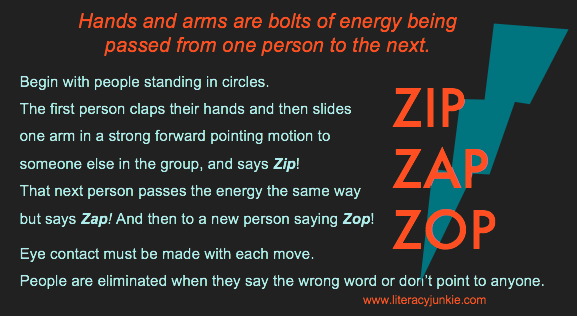
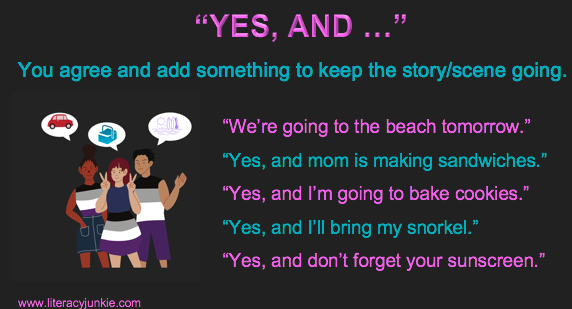
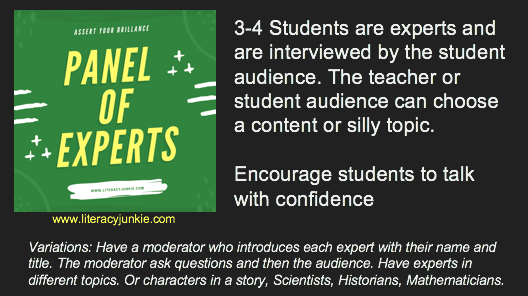
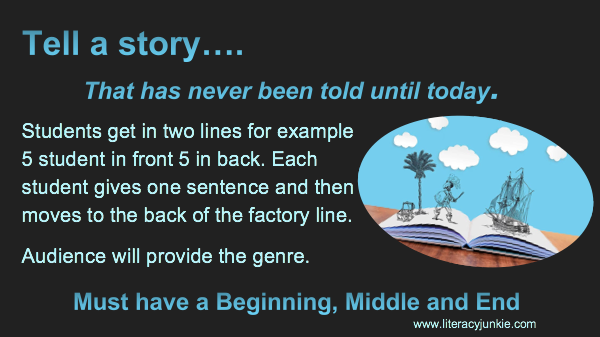
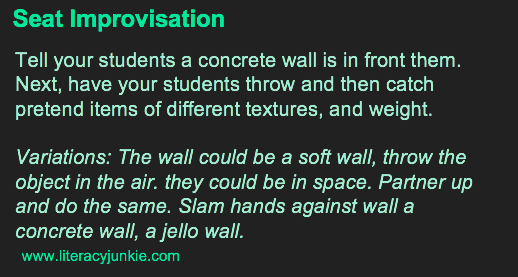
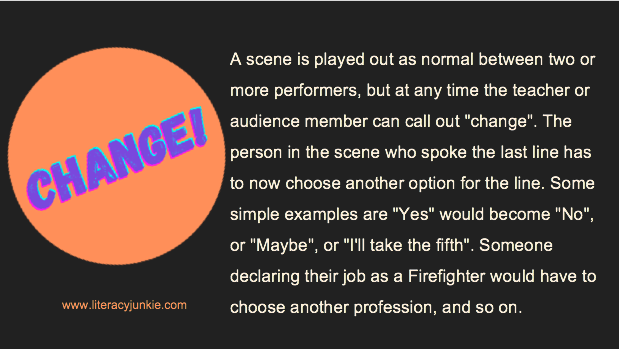
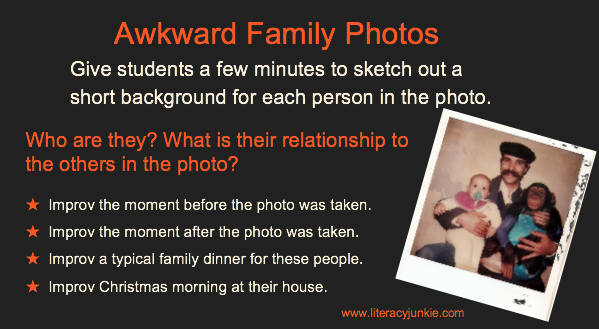
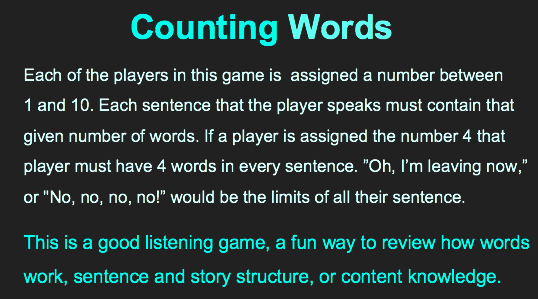
References
Watland, K.H. & Santori, D. ( 2014). Say “Yes and” to students learning teamwork! Using Improv in the college classroom to build teamwork skills. Journal of Learning in Higher Education. Fall. 10(2), 91-97.
Zenger, Z. & Folkman, J. (2016). What Great Listeners Actually Do. https://hbr.org/2016/07/what-great-listeners-actually-do


